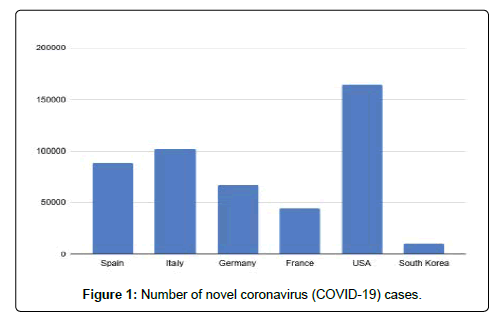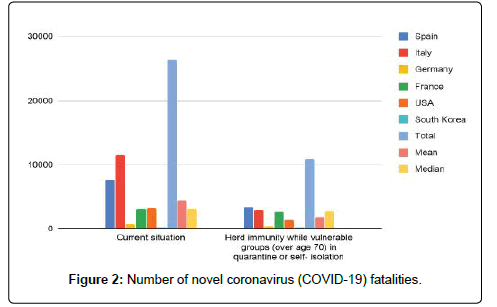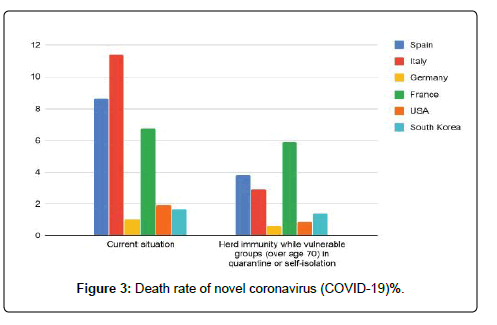Herd Immunity without the Frail Sheep
Received: 03-Apr-2020 / Accepted Date: 21-Jul-2020 / Published Date: 28-Jul-2020 DOI: 10.4172/2161-1165.1000382
Abstract
Background: In 2020, a newly-discovered infectious viral disease, known as coronavirus disease, caused by the new COVID-19, became a pandemic, with no vaccine currently available. Many countries were not ready to face this pandemic crisis. With 3.4% mortality rate and the WHO risk assessment of the disease at the global level is very high, with 634,835 cases and 29,891 deaths reported as of this writing. Some approaches that are being applied to slow down the pandemic and ease pressure in hospitals and flattening the curve of the disease, include curfew and lockdown. However, even with all these measures being applied, the number of newly- discovered cases is still increasing, indicating that something is missing in this puzzle. If a new addition to the old concept of herd immunity is applied, would the number of deaths and death rate decrease? In this research, this method would be applied to the study of COVID-19 in Italy, Germany, Spain, France, the USA, and South Korea. This new concept would be called “herd immunity without the frail sheep,” in which vulnerable groups would be in quarantine or self-isolation while allowing herd immunity to take place with the rest of the population.
Methods: This is quantitative research in which the data (number of cases, number of deaths, rate of death) was collected from Statista and WHO. In order to indicate the effectiveness of this new concept with the current situation which is a mixed of unrestricted herd immunity and partial curfew.
Results: The findings lead us to conclusions that if the vulnerable group for any upcoming epidemic was isolated Quickly- such a move will significantly decrease both the number of fatalities and rate of death.
Discussion/conclusion: The concept of herd immunity without restriction and with no vaccine poses ethical dilemmas in terms of building community immunity on the shoulders of vulnerable groups. The reason behind conducting this study is to find a way in which society can continue to function with little interruption in the face of the pandemic while still protecting vulnerable groups.
Keywords: Pandemic; COVID- 19; Herd immunity
Background
In 2020, a newly-discovered infectious viral disease, known as coronavirus disease, caused by the new COVID-19, became a pandemic, with no vaccine currently available [1]. The majority of infected patients have mild respiratory symptoms, while the elderly, the immuno-compromised and patients with chronic or underlying illnesses suffer far more severe symptoms that can become fatal. Many countries were not ready to face this pandemic crisis due to a shortage of time to prepare, lack of clear guidelines on how to deal with it, financial issues, and open borders, among other issues. Many approaches are being used to attempt to combat this pandemic, which has now reached a worldwide 3.4% mortality rate [2]. As of the beginning of March (2), the WHO risk assessment of the disease at the global level is very high, with 634,835 cases and 29,891 deaths reported as of this writing and numbers increasing every day. Some approaches that are being applied to slow down the pandemic and ease pressure in hospitals and flattening the curve of the disease, include curfew, lockdown, isolation, travel bans, social distancing, closed schools and airports, and many other similar measures [3]. However, even with all these measures being applied, the number of newly-discovered cases is still increasing, indicating that something is missing in this puzzle. Are these measures working at all? For how long can we stand in a defensive position? Herd immunity is the idea of protecting vulnerable groups of people from an infectious disease, while a sufficient number of the rest of the population are immunised by vaccines or previous infections, cutting the chain of infection before reaching it to the vulnerable groups as a result. If a new addition to the old concept of herd immunity is applied, would the number of deaths and death rate decrease? In this research, this method would be applied to the study of COVID-19 in Italy, Germany, Spain, France, the USA, and South Korea, comparing the number of fatalities and mortality rate pre and post using this method. The reason for selecting these countries is because they are not where the pandemic started, and so in theory could have time to apply the herd immunity method. This new concept would be called “herd immunity without the frail sheep,” in which vulnerable groups would be in quarantine or self-isolation while allowing herd immunity to take place with the rest of the population, taking into account that no vaccine is currently available. Since the majority of death occurs in the 60+ age group, the research would consider people in the age group over 70 as a vulnerable group who would not mix with society and would be placed in quarantine or self-isolation [4]. While there are of course other groups at high risk for COVID-19, such as people with chronic diseases, for the sake of simplicity, the research will test this new concept on people over age 70 being isolated from the rest of society. The basic reproduction number (R0) is between 2 and 3, with a median of 2.5, so the vulnerable group in our study would be quarantined until 60% of the population are infected and develop immunity, giving us more time to develop accurate diagnostic kit tests for the disease [5].
Methods
This is quantitative research in which the data (number of cases, number of deaths, rate of death) was collected from Statista and WHO. The data was used to see if, when isolating people over 70 years, the concept of “herd immunity without the frail sheep,” is effective in decreasing the number of fatalities and rate of death more than the current situation. Many countries apply only partial curfew; people can still communicate, take public transport, go shopping, etc. However, partial curfew was only recently applied in some countries, so this will not yet have a huge effect on the current data. As a result we considered the current situation as mixed of normal herd immunity and partial curfew.
Results
The results represented in Figures 1-3 and Tables 1-3 are being produced as the pandemic continues and takes as on 30/03/2020.
| Spain | Italy | Germany | France | USA | South Korea |
|---|---|---|---|---|---|
| 87,956 | 1,01,739 | 66,885 | 44,550 | 1,64,266 | 9,786 |
Table 1: Number of novel coronavirus (COVID-19) cases (6,7,8,9,10,11,12).
| Spain | Italy | Germany | France | USA | South Korea | Total | Mean | Median | |
|---|---|---|---|---|---|---|---|---|---|
| Current situation | 7,716 | 11,591 | 645 | 3,024 | 3170 | 162 | 26,308 | 4384 | 3097 |
| Herd immunity while vulnerable groups (over age 70) in quarantine or self isolation | 3,356 | 2,99 0 | 387 | 2,63 9 | 1,385 | 143 | 10,900 | 1816 | 2704 |
Table 2: Number of novel coronavirus (COVID-19) fatalities (6,7,8,9,10,11,12).
| Spain | Italy | Germany | France | USA | South Korea | |
|---|---|---|---|---|---|---|
| Current situation | 8.67 | 11.39 | 1.02 | 6.79 | 1.92 | 1.66 |
| Herd immunity while vulnerable groups (over age 70) in quarantine or self isolation | 3.8 | 2.9 | 0.578 | 5.9 | 0.843 | 1.4 |
Table 3: Death rate of novel coronavirus (COVID-19) % (6,7,8,9,10,11,12).
Discussion/Conclusions
a. The number of fatalities due to COVID-19 in 6 countries in the current situation (no herd immunity) was 26,308. After applying the new concept, this number decreased to 10,900- a reduction of approximately 40%.
b. In Spain, Italy, the USA and Germany, the number of fatalities due to COVID-19 lowered by half after applying the new concept.
c. In Italy, where the largest number of deaths occurred due to COVID-19, this number decreased by 75%, while in South Korea, where the lowest number of deaths occurred, the reduction in fatalities after applying the new concept was about 12%.
d. The rate of death ranged from 1.02% to 11.39% in the current situation, while after applying the new concept, this rate ranged from 5.78% to 5.9%.
e. In Germany, Italy, Spain and the USA, the death rate decreased by half after applying the new concept; the most dramatic decrease was in Italy, where percentages were reduced from 11.39% to 2.9%.
f. In France, the rate of death decreased by almost 1% after applying the new concept, while in South Korea, the figure lowered by 0.2%.
All the above findings lead us to the conclusion that if the vulnerable group for any coming epidemic were isolated quickly- such a move will significantly decrease both the number of fatalities and rate of death. The reason behind conducting this study is to find a way in which society can continue to function with little interruption in the face of the pandemic while still protecting vulnerable groups. Although many countries have recently enforced curfews, total lockdown, and travel bans, the number of people being infected by the pandemic is still doubling on average every 6 days- a high number considering the impractical move of shutting down all direct communication and public transportation. Since these measures are only for slowing down the number of cases, we must either find a vaccine as soon as possible or slow down the number of cases further so as not to cause the overwhelming number of patients being admitted to hospitals and cause further stress to healthcare systems. An especially high percentage of patients with COVID-19 require hospital treatment at 19%, while the percentage of ICU admissions is at 6%. Needless to say, the concept of herd immunity without restriction and with no vaccine poses ethical dilemmas in terms of building community immunity on the shoulders of vulnerable groups. This is the reason why this research tested the concept of herd immunity without the ‘frail sheep’, or the vulnerable group, until over 60% of our invulnerable community achieves immunization by normal social mixing [6,7].
Limitations
- COVID-19, like any viral illness, has a short incubation period, so the number of incidences may be underestimated.
- There is a lack of diagnostic test kits in some countries, or test kits are only being used for severe patients who enter hospitals and medical clinics.
- The death rate is also affected by the number of hospital staff and available ICU beds and ventilators, and not strictly by the age of the patient.
References
- WHO Director-General's opening remarks at the media briefing on COVID-19, March 3, 2020.
- Clinical Characteristics of 138 Hospitalized patients with 2019 novel coronavirus infected pneumonia in Wuhan, China – Wang, JAMA, 7 Feb, 2020.
- Novel coronavirus disease 2019 (COVID-19) pandemic: increased transmission in the EU/EEA and the UK- sixth update (2020)
- Â Joseph TW, Kathy L, Gabriel ML (2020) Nowcasting and forecasting the potential domestic and international spread of the 2019-nCoV outbreak originating in Wuhan, China: a modelling study. The lancet journal 395: 689- 697.
- CDC COVID-19 Response Team. Severe Outcomes Among Patients with Coronavirus Disease 2019 (COVID-19) United States, February 12- March 16, 2020. MMWR Morbidity and mortality weekly report. (2020).
Citation: Almutairi H (2020) Herd Immunity without the Frail Sheep. Epidemiol Sci 10: 382. DOI: 10.4172/2161-1165.1000382
Copyright: © 2020 Almutairi H. This is an open-access article distributed under the terms of the Creative Commons Attribution License, which permits unrestricted use, distribution, and reproduction in any medium, provided the original author and source are credited.
Select your language of interest to view the total content in your interested language
Share This Article
Recommended Journals
Open Access Journals
Article Tools
Article Usage
- Total views: 2235
- [From(publication date): 0-2020 - Nov 16, 2025]
- Breakdown by view type
- HTML page views: 1396
- PDF downloads: 839



